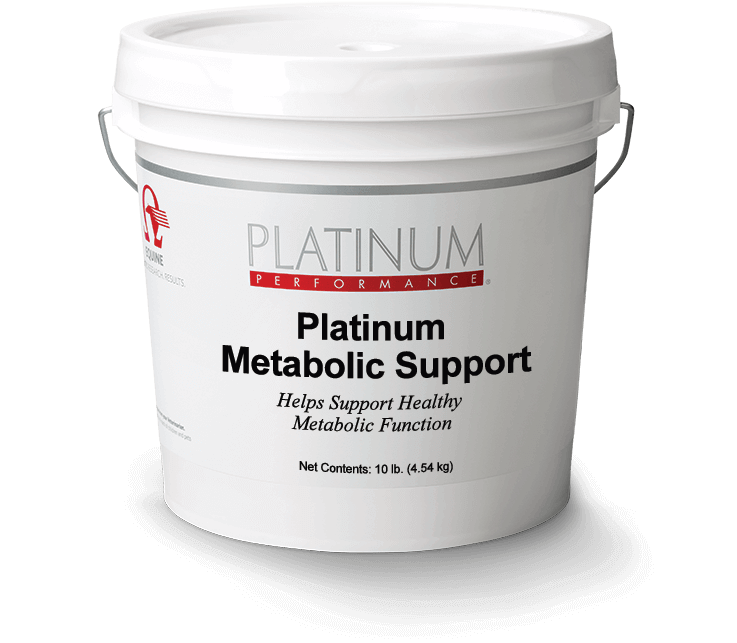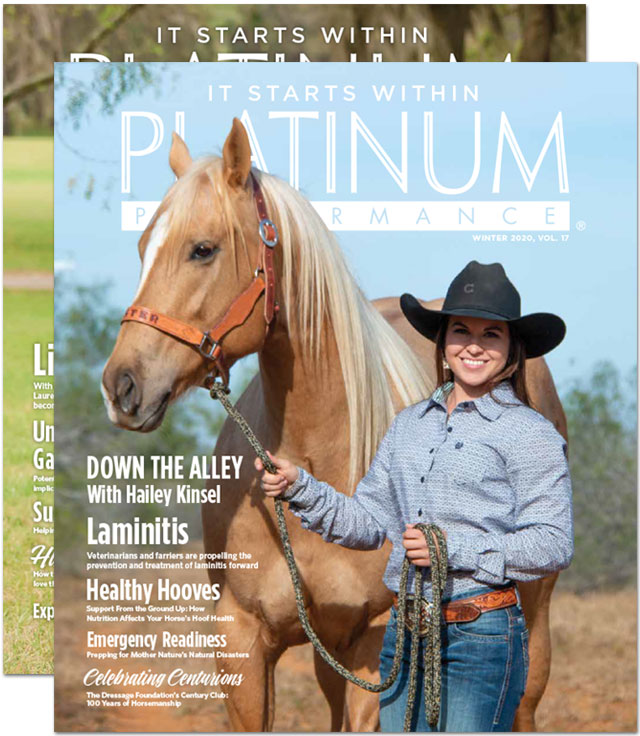Examining Risk Factors, Identifying Symptomology and Outlining Important Dietary Intervention Strategies for Equine Metabolic Syndrome and Insulin Dysregulation as well as Pituitary Pars Intermedia Dysfunction
Metabolic syndrome. It’s a condition that’s reached epidemic proportions in human medicine and one that frequently impacts horses as well. The effects can be devastating for human or horse, with a spectrum of metabolic conditions wreaking havoc on health and longevity. While individual genetics can play a role in the development of metabolic syndrome, there is no doubt that too many of the wrong calories and too little exercise are very common risk factors.
As is the case for most scary scenarios, there’s light at the end of the tunnel for those willing to look for it. Dr. Jenifer Gold, an equine veterinarian with Wisconsin Equine Clinic and Hospital in Oconomowoc, is board-certified in internal medicine and equine emergency and critical care. Together with Abby Keegan, an equine clinical nutritionist with Platinum Performance® who has a master’s degree in animal science with a focus in equine nutrition from Kansas State University, the two are lending their expertise to detail just what we’re dealing with and the steps to consider in helping prevent a metabolic storm.
Equine Metabolic Syndrome (EMS) and Insulin Dysregulation (ID)
“First and foremost, what are we concerned about here?” Keegan asks rhetorically. “Your veterinarian is monitoring your horse for signs that they may have EMS because the underlying fear is the potential for laminitis. By identifying horses with this collection of risk factors, proper management can be implemented and monitored with hopes to ward off that fear.” It turns out that understanding the role of glucose and insulin, along with the crucial way they interact within the body, is paramount to prevention and getting to the root cause of poor metabolic health. “EMS is described as a collection of risk factors highly-associated with an increased risk of hyperinsulinemic-associated laminitis (HAL),” details Keegan; “the one that is always present in every horse diagnosed with EMS is ID. Many people are more familiar with the term insulin resistance, but these days insulin dysregulation, or ID, is really the collective term that describes elevated basal or resting insulin levels or actual insulin resistance.”
“When we talk about horses with EMS, some degree of ID is always present; hence the two terms are used a bit interchangeably. As we think about insulin dynamics, we think about the cells in a horse's body. Every cell requires glucose as its energy source so it can function. I like to use this analogy — imagine there’s a ‘gate’ as a barrier to glucose entering the cell in the horse’s body, and that gate requires a ‘key’ to unlock it. The key represents insulin, and the ‘gate’ represents the insulin receptor on the cell. Glucose is absorbed into the horse’s bloodstream after eating a meal, and to get glucose from the bloodstream into the cell and past that gate, the horse secretes insulin. Insulin essentially unlocks the gate to let the glucose into the cell.” Keegan’s analogy paints a picture of the biologic process in a normal horse, but what about an insulin resistant equine? “In a horse with IR the insulin receptor gate doesn’t work correctly, so more insulin keys are produced to try and unlock the gate. Typically, a horse consumes a meal and glucose levels rise in the bloodstream, which signals the pancreas to secrete insulin. When the key doesn’t work, glucose can’t get into the cell and levels stay high in the bloodstream triggering the pancreas to secrete more insulin, exacerbating a host of challenges in the horse. Namely, our main fear is laminitis. It is documented that high insulin levels can induce laminitis.”
“These conditions — PPID and ID — have been lumped together frequently, but they’re not the same. It’s been estimated that about one-third of all PPID cases in fact have EMS, or ID.”
— Dr. Jenifer Gold, An equine veterinarian with Wisconsin Equine Clinic and Hospital in Oconomowoc, board-certified in internal medicine and equine emergency and critical care
The Nuances of PPID
Pituitary pars intermedia dysfunction is a typically age-related malfunction of the pituitary gland that can cause insulin dysregulation, weight loss, a decrease in muscle tone and topline condition, a ribby appearance and a wavy haircoat. “PPID horses are lacking in sufficient dopamine,” explains Dr. Gold. “Interestingly, there’s now going to be collaboration between equine and human medicine because of the similarities — humans with Parkinson’s disease and horses with PPID both lack adequate dopamine — and we don’t yet understand exactly why.” It’s that lack of dopamine that is a primary driver of PPID symptoms, as well as the levels of ACTH and other hormones.
It’s important to note that while roughly one-third of aged PPID horses may have PPID and EMS, the other two-thirds only have PPID and fortunately don’t require such strict dietary management. “For those horses that have PPID with ID (EMS), we have to follow the rules of equine metabolic syndrome with regard to really controlling the nonstructural carbohydrates (NSC) intake in their meals,” Keegan says. Although many horses with PPID are not insulin dysregulated, it’s important to work with your veterinarian to get proper testing and examination underway to determine if PPID alone is at play or if insulin levels are also abnormal. “These are the tricky ones,” she says. “These horses have been diagnosed with both PPID and ID, but they’re hard keepers, meaning they’re below an ideal body condition score (BCS). For those horses, we need to think about creative ways to bring calories into the diet without exacerbating their glycemic response.” For these cases, Keegan often recommends choosing a forage (hay) that is higher in calories but still controlled or lower in NSC. Alfalfa can be an excellent choice. When additional calories are needed beyond that, other sources of highly-soluble fiber or healthy fats, such as flax oil, can be considered.
PPID horses face similar risk factors that can place them in the path of significant health complications, particularly those also experiencing ID. “We know that high levels of insulin directly affect and create laminitis,” says Dr. Gold. “These conditions — PPID and ID — have been lumped together frequently, but they’re not the same. It’s been estimated that about one-third of all PPID cases in fact have EMS, or ID.” The fortunate news is that if your horse is diagnosed with PPID but does not have ID, we don’t have to be as restricted in monitoring the NSC content of the hay being fed.
Defining Common Equine Endocrine Disorders
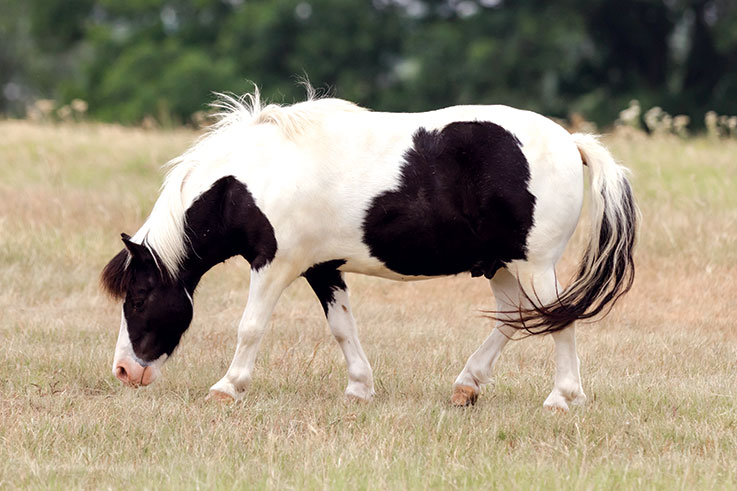
Equine Metabolic Syndrome (EMS)
Symptoms include:
- Insulin Dysregulation (collective term for any combination of basal or postprandial hyperinsulinemia or insulin resistance)
- Obesity/Adiposity (regional or general)
- Endocrinopathic Laminitis (or a pre-disposition to it)
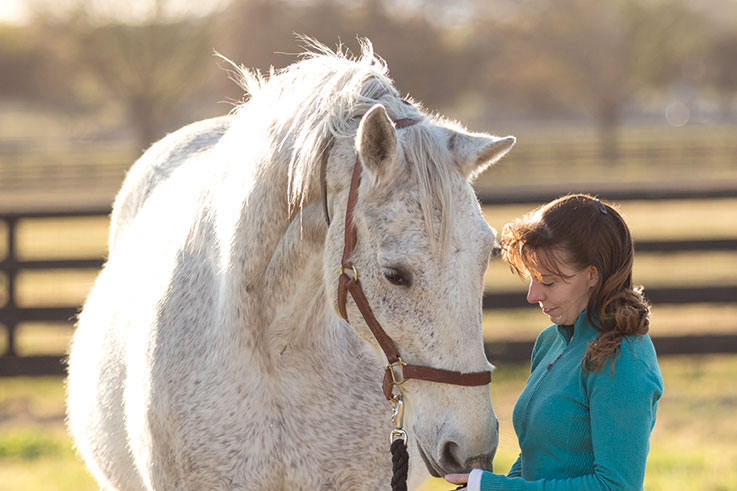
Pituitary Pars Intermedia Dysfunction (PPID)
Also known as Equine Cushing’s Syndrome
Symptoms include:
- +/- Insulin Dysregulation (this may or may not be present in horse)
- Abnormal ACTH Concentration (Adrenocorticotropic Hormone)
- Advanced Cases Often Display Hypertrichosis (long hair coat), difficulty shedding and loss of topline among other clinical signs
* Note: Horses may have one or both endocrine disorders
Necessary Testing
A close relationship between the rider and their equine veterinarian is imperative in identifying the potential for a metabolic disorder, diagnosing a present condition and devising a management strategy for prevention or treatment. Testing options range from the all-important physical examination, where the veterinarian will assess the horse’s body condition for the presence of obesity or regional adiposity, to a short list of medical tests that will provide hard numbers. These tests typically include a basal insulin test, followed by more dynamic tests that can include an oral sugar test or insulin tolerance test. Gauging the horse’s resting or basal insulin level after fasting is generally the starting point, with the normal baseline considered to be less than 20 μU/mL. Establishing a baseline for each individual horse is key. One horse’s “normal” is not necessarily the same for every animal.
The Karo® Light Corn Syrup test is another tool; it introduces oral sugar to the horse prior to testing insulin levels. “They get .45 ml/kg of the syrup and, unlike a fasting test, they can have had hay up until 10 o’clock the night before. The syrup is administered, usually in the morning, then 60-90 minutes later, the veterinarian will take a sample and analyze insulin and glucose levels,” explains Dr. Gold. The takeaway is veterinarians have several helpful tests, including their eyes and hands, to establish an accurate diagnosis of or rule out EMS or PPID.
Primary testing for pituitary pars intermedia dysfunction (PPID) includes a non-fasting plasma ACTH level (normal is considered <30 pg/mL from September down to <15 pg/mL from December to June, and intermediate levels between these periods). For horses with early signs or equivocal test results, a TRH (thyrotropin-releasing hormone) stimulation test from January through June can be helpful. In this test, blood is drawn for a baseline ACTH level, followed by an injection of TRH, then a second ACTH level is acquired at the ten minute mark. For this stimulated test, ACTH should remain below 100 pg/mL.
“I try to help my clients understand the role that ID plays in their horses and in their laminitis risk. It really is serious.”
— Dr. Jenifer Gold, Wisconsin Equine Clinic and Hospital
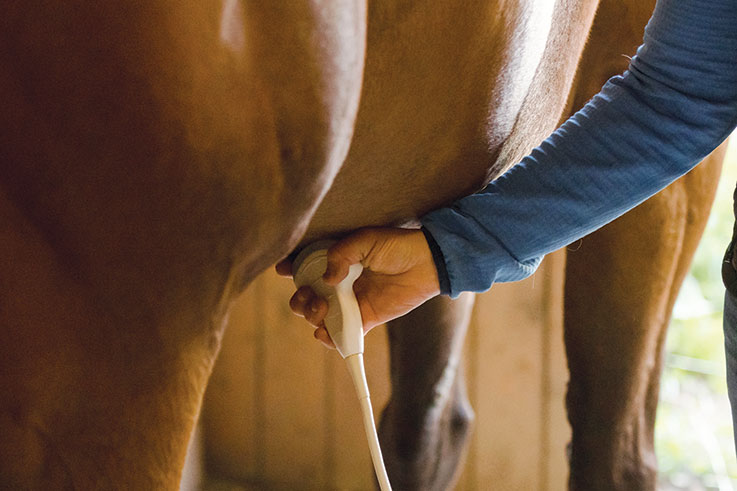
“Some of these metabolic horses don’t look overweight on the outside, but then we ultrasound them and they have a 4-inch fat pad inside, which is still metabolically active,” says Dr. Jenifer Gold. “Sometimes these horses aren’t followed as closely because the outward signs aren’t there. I always recommend having the veterinarian do a quick scan to see how much intra-abdominal fat is present.”
How Body Condition Plays a Role
In addition to heightened or abnormal insulin levels, other common signs that metabolic concerns are either brewing or already at play are obesity, or an unhealthy high body condition score, along with regional adiposity, or fatty deposits in places like the tailhead or along the neck. The Henneke Body Condition Scoring method designates a horse as a 1-9 based on general fat coverage determined by palpation of key areas of the horse’s body. “In the case of EMS, generally horses are found to have a BCS greater than 7 indicating obesity; however, the horse may not even be generally obese, they may just be exhibiting signs of regional adiposity, i.e. fatty deposits around their sheath. This elevated BCS combined with abnormally-high resting or postprandial insulin levels can predispose horses to a number of health risks and pave the way for laminitis.” While the majority of horses experiencing EMS are in fact overweight, veterinarians will inevitably be confronted with tougher cases to identify; cases where the horse has an ideal or even slightly-light BCS but is still dealing with abnormal glucose and insulin levels beneath the surface. “These guys are tricky,” confirms Dr. Gold. “Some of these metabolic horses don’t look overweight on the outside, but then we ultrasound them and they have a 4-inch fat pad inside, which is still metabolically active.” In these cases, adipocytes are still very much present, and the risk for high leptin levels is there in spades. “It’s the slimmer cases I sometimes worry more about,” says Dr. Gold. “Sometimes these horses aren’t followed as closely because the outward signs aren’t there. I always recommend having the veterinarian do a quick scan to see how much intra-abdominal fat is present.”
Whether the horse is obese, showing signs of regional adiposity or completely lacks the telltale outward signs of EMS, any horse with insulin dysregulation is at a significantly-higher risk for health complications, especially the dreaded diagnosis of laminitis. “I try to help my clients understand the role that ID plays in their horses and in their laminitis risk. It really is serious,” cautions Dr. Gold.
How Much Forage to Support an Ideal BCS?
Scenario
Current BCS: 7.5
Ideal BCS: 5.5
Current Weight: 1,240 lbs
Ideal Weight: 1,150 lbs
Doing the Math
Each BCS = approx. 45 lbs
BCS: 7.5 - ideal BCS: 5.5 = 2 BCS
45 lbs x 2 = 90 lbs
Weight – Weight Reduction Needed = Ideal Weight
1,240 lbs - 90 lbs = 1,150 lbs
Ideal Weight x 1.5% = forage/day
1,150 x .015 = 17.25 lbs/day
“Upwards of 90% of laminitis cases are thought to be endocrinopathic, or metabolically related.”
— Abby Keegan, MS, PAS, Platinum Performance® Equine Clinical Nutritionist
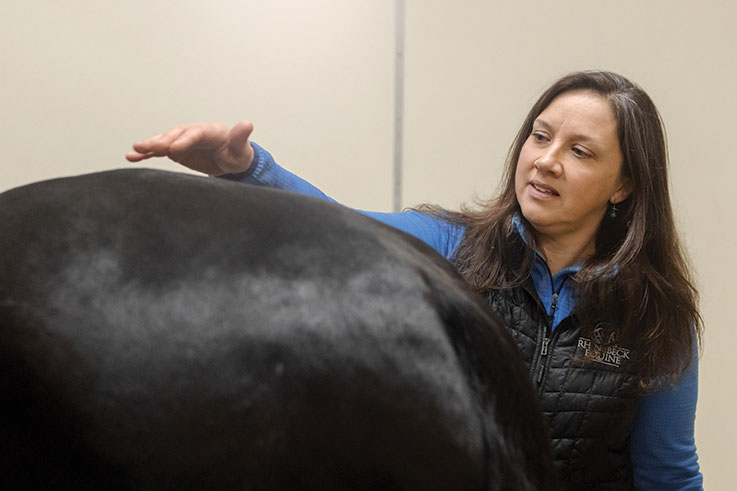
Dr. Laura Javsicas, a board-certified equine internal medicine specialist and partner at Rhinebeck Equine, examines regional adiposity.
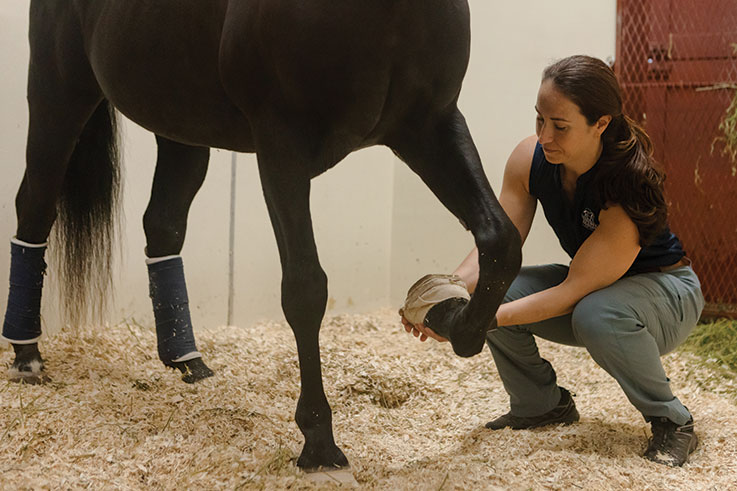
Dr. Jesse Tyma, a board-certified equine surgeon at Rhinebeck Equine in New York, examines the feet of “Belle,” a hospitalized EMS case with chronic laminitis.
Laminitis: The Ultimate Foe
The path to laminitis often includes obesity as the first step on a dangerous journey. There are several causes of laminitis, including contralateral limb laminitis after orthopedic injury to the opposite leg, in addition to sepsis-related laminitis from retained placentas and toxicity. Endocrinopathic or hyperinsulinemic-associated laminitis (HAL) is the leading cause of this all-consuming condition, and in more cases than not, it starts with excess weight and ID.
This conversation puts veterinarians in a difficult position and leaves them as the bearer of unwanted news. Imagine having to tell your client — a person you respect as a horseman or woman — that their horse is overweight or even obese and that — along with possible influence of health history and genetics — the feeding regimen that client has designed could be the cause. As clients, we need to understand that a good veterinarian is one who has those hard discussions and puts the horse first. It’s their job to ensure our horses are healthy. It’s the horse owner’s job to take that news and make the necessary changes.
Laminitis is the predominant underlying concern and frequent result of these genetic, obesity or excess adiposity-induced conditions. This disease starts with a breakdown within the laminae, the strong but resilient connections between the hoof and the coffin bone (aka P3, distal phalanx), leading to rotation or, even worse, sinking of P3 away from the hoof wall. While the bone can go by many names, the result is the same: potentially devastating, career limiting/ending or fatal impact. Veterinarians are all too aware of the vast number of reasons equine metabolic health needs to be properly managed. Laminitis results in extreme pain, ischemia (loss of blood flow), inflammation and often permanent and severe lameness, if not death. “Upwards of 90% of laminitis cases are thought to be endocrinopathic, or metabolically related,” Keegan says. It’s a staggeringly high figure, and while EMS and related conditions can have very real and negative effects on several aspects of your horse’s health, laminitis is the most devastating of them all. “That’s really what your veterinarian is trying to do; to recognize the horse that could potentially have a hyperinsulinemic-associated laminitis, or high levels of insulin set to cause a potential laminitis case,” she adds. The great veterinarian Dr. Mark Silverman — a nationally-recognized expert in equine podiatry as well as a dressage competitor — said: “Prevention is invaluable. Once a horse is laminitic, we’re pushing a boulder up a hill with our nose.” Translation: Early intervention is key, and once this disease state enters the room, the outcome is rarely favorable despite all efforts. It’s the foe you don’t want to tangle with.
“We want fiber continuously moving through the horse’s digestive system, and to have them chewing for as many hours as possible during the day. The more they chew, the more saliva that’s produced. That saliva buffers the acid that’s continuously produced in the stomach.”
— Abby Keegan, MS, PAS, Platinum Performance® Equine Clinical Nutritionist
What Do I Feed?
Ultimately, the discussion may start with calories, but what type of calories and from where are the keys. “If your horse has been diagnosed with a BCS that is too high (indicating overweight), the first thing we’ve got to think about is pulling calories out of their diet,” Keegan explains. “As an example, let’s say your horse has been diagnosed as a bit overweight, and they’re also showing high basal insulin levels — they’re insulin dysregulated and hence fall into the class of EMS.” Avoiding unnecessary calories in the diet is key as well as developing a strategy as to how to restrict calories and get the horse back to a healthy BCS.
Keegan, like most equine nutritionists, is adamant that high-quality (albeit perhaps not high in calorie) forage is the foundation of the diet. “The first step in reducing a horse’s BCS (presuming that all unnecessary calories coming from feeds have already been removed) is to look to our actual forage intake level. We want the diet to be comprised primarily of forage and for that forage to ideally be the source of any needed calories, rather than feeds. With most horses, the goal is for them to consume as much forage as possible; however, with our overweight individuals, we need to restrict those calories, and that starts with understanding total hay intake. A good rule of thumb when looking to reduce calories is to start by weighing the total pounds of hay fed per day, then reducing that intake to 1.5% of the horse’s ideal — not current — body weight.” Keep in mind that each BCS score represents roughly 45 pounds of weight loss for an average-sized light breed horse. “We would use that ideal body weight to calculate our initial goal for hay intake per day.” Keegan recommends that if a horse is at that rate of forage for one month and still not losing body condition, the daily hay ration can drop further, but to no less than 1.2-1.3% of their ideal body weight. However, you should consider incorporating lower-calorie types of hay as well. “It’s all about balance, and finding the right hay to feed these horses can be tricky,” Keegan admits. She gives the simple tip of utilizing a weight tape or weight calculation method on your horse to establish current body weight if a scale isn’t available, then buying a luggage or fish scale to weigh each serving of your horse’s hay to see exactly what they’re consuming. Another go-to trick is to use a smallholed nibble net that forces your horse to eat slowly and continuously throughout more of their day. “We want fiber continuously moving through the horse’s digestive system and to have them chewing for as many hours as possible during the day,” Keegan says. “The more they chew, the more saliva that’s produced. That saliva buffers the acid that’s continuously produced in the stomach.”
Designing a feeding regimen based on the right amount of high-quality forage combined with the right supplementation is ideal. This curtails excess calories but ensures that the calories being fed are nutrient dense. In addition, minimizing or eliminating grains and concentrates for EMS and ID horses is recommended. “It’s about choosing the right calories,” Keegan says emphatically. “A pound of gummy bears isn’t the same as a pound of broccoli. One fills us up, and the other does the same thing while nourishing us.”
Calculating a Total Dietry % NSC
x 15 lbs
x 0.29 lbs
+ 0.03 lbs NSC from supplement
÷ 15.29 lbs (total fed)
9.03% NSC is within the 10-12% recommended maximum, so this diet works well
x 15 lbs
x 3 lbs
+ 0.3 lbs NSC from senior feed
÷ 18 lbs (total fed)
14.16% NSC is NOT within the 10-12% recommended maximum, so this diet needs to be adjusted
Nonstructural Carbohydrates
Understanding nonstructural carbohydrates is also an essential part of properly managing horses with EMS, but it’s also one of the most misunderstood pieces to the puzzle. “We as an equine community have done a great job of educating around some of these metabolic disorders and the fact that we need to control nonstructural carbohydrates in the diet,” says Keegan. “At the same time, some of it has become a bit misconstrued and can get confusing pretty quickly.”
Keegan outlines that horses with EMS should consume a diet containing less than 10-12% total dietary nonstructural carbohydrates — starches, sugars and fructans. “It’s vital to keep in mind that when you’re feeding a product to your horse — whether that be a grain, concentrate or even a supplement — and you see the percentage of nonstructural carbohydrates listed, it’s all about the amount in a meal and also how that product plays into the horse’s diet as a whole,” she says. While grains and concentrates should be minimized significantly (or completely eliminated) for most horses with EMS, be sure to read labels and do the necessary math if you’re choosing to still feed them. “The easiest way to think about it is that forage (high-quality hay) should be the primary component of the horse’s diet while everything else should be given in much smaller amounts,” Keegan says.
One of the most important choices in managing EMS horses is the quality, amount and type of forage we provide. “This is where testing your hay is important,” Keegan explains, “so you can better understand what that particular hay is giving you.” Surprisingly to some, alfalfa can be an excellent choice. “Unlike grasses, alfalfa does not contain fructans. Sometimes alfalfa can actually have a lower NSC content than a grass hay,” she adds. In the less commonly-seen EMS cases where the horse is ID but thin, alfalfa can be a great solution because it often contains more calories per pound but with a lower NSC content. Another way to add those calories for lighter EMS horses is to increase the fat intake from a healthy fat source. “Platinum’s Healthy Weight is a cold-pressed flaxseed oil infused with all-natural vitamin E. It’s one of my favorite formulas, and it allows you to add calories to the diet without increasing the NSC levels,” adds Keegan.
Without hay analysis, owners and riders unfortunately are flying relatively blind. Luckily, sending a hay sample for testing is easy and cost-effective. There are numerous labs that perform the service and provide a detailed report back. The key numbers on that report are water-soluble carbohydrates (an estimate of sugar and fructans) and the starch content (dry matter). “Take the water-soluble carbohydrate content and the starch content, then simply add those two numbers together,” Keegan directs. “That’s going to tell you the nonstructural carbohydrate content in that particular hay.” If your hay report indicates an NSC content of 14%, for instance, that’s a good indication that soaking your hay may be an excellent tactic. Dr. Gold recommends a 30-minute soaking to essentially wash away excess sugars. “What we often forget is that while we’re leaching out the sugars and starches, we’re also leaching minerals and other necessary nutrients out of the hay as well,” cautions Dr. Gold. “This is why I recommend that the horses are on a supplement to give them the vitamins and minerals they need as we’re trying to get those NSCs out of their hay.” While it seems obvious, the water now contains those excess sugars and starches. “After soaking the hay, I always make sure to tell owners and riders to throw that water away, and don’t give it to the horse,” Keegan says. Keegan and Gold acknowledge some barns must purchase hay more frequently than others, making NSC content knowledge of hay challenging. In these cases, the pair suggest soaking hay for 30 minutes as a precautionary measure.
Once you’ve limited calories and understood the horse’s total daily NSC intake, the next step may involve your veterinarian further testing your horse’s individual response to the meal. “The more information the better,” Keegan says. “You’re looking for that high-quality, low NSC hay, you’re looking to decrease or eliminate grains and concentrates in these EMS horses, and you really need to be aware of the NSC content and amount of any other feeds or supplements being given to the horse.”
“What we often forget is that while we’re leaching out the sugars and starches, we’re also leaching minerals and other necessary nutrients out of the hay as well. This is why I recommend that the horses are on a supplement to give them the vitamins and minerals they need as we’re trying to get those NSCs out of their hay.”
— Dr. Jenifer Gold, Wisconsin Equine Clinic and Hospital
Fructans: A Closer Look
Fructans are a type of storage sugar found in certain plants and cool-season grasses made from linked fructose molecules that are not directly digestible by the horse in the way that simple sugars or starches are. Studies show fructans may have significant breakdown in the stomach and small intestine, and they can cause abnormal increases in insulin levels in the face of EMS.
Studies have shown large doses of fructans will reliably induce laminitis in horses, so taking steps to limit fructan consumption in pasture and forage is commonly recommended. This is why starch plus water-soluble carbohydrates (a measure of soluble sugars and fructans) is commonly used as the estimate of NSC to make feed recommendations for EMS horses. There is still some debate about the risk that fructans pose, so some veterinarians recommend relying more heavily on levels of starch plus ethanol-soluble carbohydrates (a measure primarily of soluble sugars with minimal fructans).
There are two main types of fructans: The inulin form is found in chicory and Jerusalem artichoke; while the levan form is found in cool-season grasses. Inulin has stronger fructose-linking bonds than levan. Studies evaluating the digestion and metabolism of levan show significantly more breakdown in the stomach and small intestines than was previously recognized.
The primary breakdown product of all fructans is fructose, which is readily absorbed by the small intestine. While fructose uptake has a minimal effect on insulin levels compared to glucose in normal horses, it causes a significant increase in horses with EMS. Some researchers feel there is a high likelihood that fructose, and by extension fructans, may be a contributing cause of the development of EMS. While the jury may still be out on fructans, being water-soluble, they are removed from soaked hay.
— By Matt Durham, DVM, DACVSMR
Supplementation
While exercise, caloric and NSC control within diet are the imperative one-two punch to support horses either at risk for or diagnosed with EMS, supplementation for total body wellness — and more specifically, for metabolic health — can be an excellent tool. “The founder of Platinum Performance®, Dr. Doug Herthel, was certainly ahead of his time in terms of really basing the diet on high-quality forage and in developing Platinum Performance® Equine to supply vital nutrients without contributing in any significant way to a horse’s NSC load,” Keegan says of the late veterinarian’s influence. “When we think about EMS horses and how those cells are interacting with one another, as well as how the cellular membrane and the mitochondria within the cell work, Platinum Performance® Equine is really taking a whole-horse approach that drives down to support at the cellular level.” This formula provides vitamins and trace minerals to fill the ever-present nutritional gaps in the equine diet, as well as the omega-3 fatty acids, antioxidants and amino acids to support normal inflammatory pathways and aid in the body’s natural defense against oxidative stress. Combined with high-quality, low NSC forage, any of these three “foundation” formulas can be an excellent choice for most horses, including those with EMS, PPID or a combination of both.
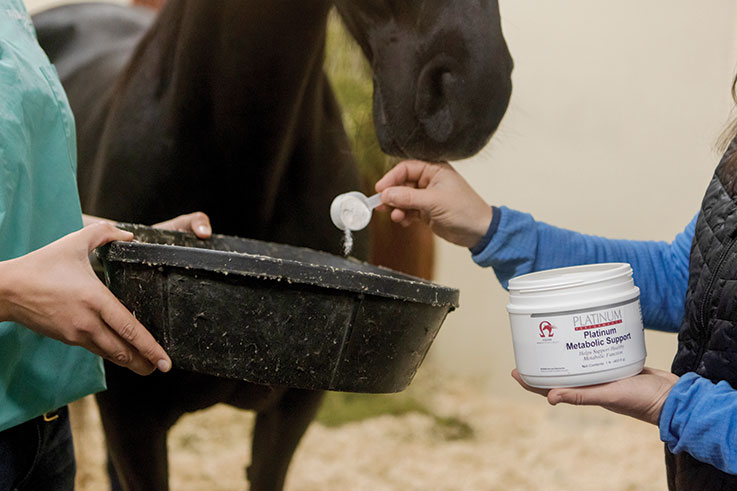
“After we start a horse on the appropriate foundation formula, if the case is advanced and calls for additional support, then we add another level,” Keegan explains. “Chromium has been shown to support insulin sensitivity in horses. Research presented in 2020 looked at horses with and without ID. It was found that the ID horses, as a group, had significantly lower levels of magnesium. Magnesium can help support normal insulin signaling pathways and normal fasting insulin concentrations.” Platinum Metabolic Support combines both chromium and magnesium citrate and is best given in conjunction with a Platinum Performance® foundation formula.
The root of most equine disease is inflammation, poor cellular health and a loss of homeostasis within the horse’s body. “Any medical therapy, medication, treatment or stand-alone supplement will typically better support a horse when they’re in homeostasis with optimal cellular health and normal inflammatory pathways,” Keegan says. “Whereas we have a greater mountain to climb with an unhealthy horse in an unmanaged state of inflammation.”
EMS & ID Myths Busted
Q&A with Abby Keegan, MS, PAS
Q: Can I Feed Glucosamine?
A: Glucosamine and glucose sound similar; they both sound like sugar. They’re very different from one another, however. Glucosamine in a well-designed formula is not going to exacerbate the insulin response or the glucose levels in a horse’s bloodstream.
Q: Is Molasses Off Limits?
A: It all comes back to the amount. When we feed these EMS horses, we want to control sugar in each meal, but the reality is we’re never going to eliminate all of it. The horse actually requires some sugar (glucose). It’s about controlling the amount that our horses are consuming. A very tiny amount of molasses — 1-2 grams — can be perfectly fine. Be sure to check with your veterinarian since they’re familiar with your horse and the overall diet you’re feeding.
Q: Does My Horse Need Pasture?
A: We all want our horses to be out on pasture, but grass contains the most nonstructural carbohydrates in terms of forage choices, especially during certain time periods and under certain conditions. If you know you have a metabolic horse, and your veterinarian has advised limited grazing access, ensure the grass is at least 6-8 inches in height and target access during only the very early morning hours when NSC levels are likely lowest. Check with your veterinarian for help on your individual case. Pasture grazing isn’t always the best choice for EMS or ID horses, but it really depends on how heavy the horse is and whether they’re insulin dysregulated. Those factors can help tell you whether some pasture grazing at the right time of day is OK or whether it’s not a good option.
Taking Action
While EMS and PPID seem prolific in today’s horse world, hope remains. As case numbers grow, so has our understanding of the conditions, as well as our grasp of how to best prevent them, mitigate their symptoms and treat the results. Equine veterinary medicine fully recognizes the severity of excess weight, abnormal insulin response and how the two interact to raise the risk of hyperinsulinemic laminitis. Giving your horse good quality forage, keeping your horse at an ideal BCS, finding an exercise regimen that works well and providing the right nutrients without excess calories will help mitigate risk factors for metabolic concerns.
It’s not just retired senior horses that struggle with these conditions. The performance horse world has more than its share of competing equine athletes that tip the scales at a high BCS and struggle with perhaps undiagnosed ID. Involving your veterinarian as a key part of your care team and proactively monitoring your horse’s metabolic health can help prevent the negative systemic effects of EMS. “These conditions trickle down to so many other issues within the body,” Keegan emphasizes. “We have the opportunity to potentially prevent metabolic issues in our horses. They eat what we feed them, and they give us their all when we ask. As riders, we have the power of prevention in our hands, and we also have the ability to make a measurable difference in horses already experiencing these conditions.”
For Blood Glucose Maintenance and To Support a Healthy Insulin Response
Metabolic conditions are on the rise, and over conditioned or obese horses are at the center of many of these health concerns. Nutrition is a significant factor for a healthy weight and body condition and can be a powerful tool to support horses with metabolic issues.
Platinum Metabolic Support provides a combination of magnesium citrate and chromium for blood glucose maintenance and to support a healthy insulin response.
Nutrients to Support Metabolic Function
-
 Chromium - Supports healthy glucose tolerance and normal blood sugar levels. This is beneficial in horses that require support to maintain normal metabolic function and a healthier body composition.
Chromium - Supports healthy glucose tolerance and normal blood sugar levels. This is beneficial in horses that require support to maintain normal metabolic function and a healthier body composition.
-
 Magnesium Citrate - Magnesium Citrate is a more bioavailable source of magnesium and is used to support the metabolism of carbohydrates, amino acids and fats.
Magnesium Citrate - Magnesium Citrate is a more bioavailable source of magnesium and is used to support the metabolism of carbohydrates, amino acids and fats.
Use With a Foundation Formula for Best Results
Omega-3 fatty acids help control glucose metabolism by optimizing cell membranes and can support healthy levels of inflammation, and the antioxidants help support the body’s natural defense against free radicals and oxidative stress.
Learn More on the Podcast
Cracking the Metabolic Code
A discussion with Equine Clinical Nutritionist, Abby Keegan, MS, examining risk factors for equine metabolic syndrome and insulin dysregulation, as well as pituitary pars intermedia dysfunction; identifying symptomology and outlining important dietary intervention strategies.
Listen




